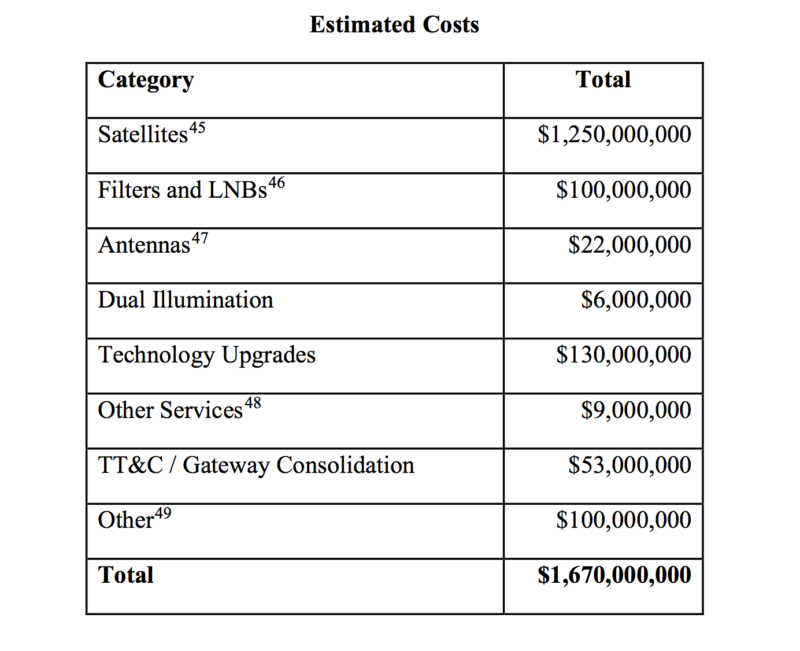Latest News

Intelsat and SES both filed their C-band spectrum transition plans with the FCC last week on June 19. The operators are working to meet the FCC’s accelerated clearing timeline to clear 100 megahertz of mid-band spectrum for commercial 5G deployment by the end of 2021, and another 180 megahertz two years later. The operators will be eligible to receive incentive payments, in addition to relocation costs, if they clear the spectrum on the FCC’s timeline. Intelsat is eligible to receive $4.87 billion, and SES is eligible to receive $3.97 billion.
Intelsat’s plan estimates the total cost of its C-band replacement satellite portion of the transition plan, including launch, insurance, and program management, to be $1.18 billion.
The operator is planning for the construction and launch of seven new satellites to create sufficient capacity to repack services and effectuate spectrum clearing. Last week, Intelsat announced that Maxar Technologies will build and deliver four satellites, and Northrop Grumman will build and deliver two satellites. The operator is also currently in negotiations with manufacturers for a seventh satellite.
Intelsat plans to launch the seven satellites on four separate launch vehicles, using at least two launch service providers. The total cost for the four launch vehicles and the associated launch insurance is estimated to be $390 million.

Intelsat’s new satellite launch program. Screenshot via Intelsat FCC filing.
Intelsat also plans to consolidate its Telemetry, Tracking, and Control (TT&C)/Gateway antennas into two remote locations on the East and West Coast of the United States. Intelsat currently operates teleports in three California cities — Riverside, Filmore, and Napa. A few of these services/carriers can be transitioned to its Paumalu teleport on the island of Oahu, Hawaii. The majority will be transitioned to Intelsat’s new West Coast consolidated TT&C/Gateway teleport in Brewster, Washington. As for the East Coast teleport, Intelsat is pursuing two options and expects to contract for this consolidated teleport site by the Fourth Quarter (Q4) of 2020.
Intelsat reports it has a team of more than 50 employees focused on the clearing initiative. The operator has also developed individual migration plans for each of its roughly 80 broadcast, cable, radio, religious and government customers to the upper 200 MHz of the C-band, including the corresponding changes required at 3,500 cable head-ends and 13,500 affiliate earth stations.
SES’s transition plan to the FCC details the operators plans for manufacturing contracts to build four satellites and two ground spares, along with changes to its TT&C operations. SES estimates the full cost of its C-band relocation program at $1.67 billion, and the operator provided a breakdown of the costs.

SES breaks down the estimated costs to clear the C-band. Screenshot via FCC filing.
Last week, SES announced Northrop Grumman and The Boeing Company will manufacture the satellites. The initial four satellites are scheduled to be launched by the end of Q3 2022. Like Intelsat, SES plans on dual launches for its new satellites to reduce the execution risk. The operator said the need to meet tight transition deadlines poses “significant risks,” and SES plans to purchase two ground spare satellites and additional launches for the ground spare satellites to guard against the risk of a launch failure.
SES’s plan said that by Dec. 5, 2021, the operator will supplement its TT&C operations to enhance two earth stations located in Hawley, Pennsylvania, and Brewster, Washington. It will complete gateway consolidation to the Hawley and Brewster sites by Dec. 5, 2023. These gateway services will operate on an unprotected basis in the 3700-3820 MHz band.
SES’s filing includes plans to migrate existing services. The operator reports 196 services that are impacted by the C-band repurposing: 114 services on domestic satellites and 82 services on international satellites. SES will be required to perform 111 frequency/satellite moves for services, gateway moves for 68 services, 11 services will require compression/modulation upgrades, and 6 mobile services may require frequency moves on the same satellite.
Stay connected and get ahead with the leading source of industry intel!
Subscribe Now